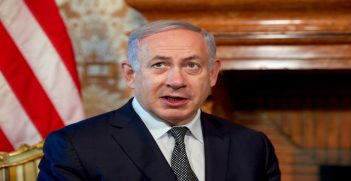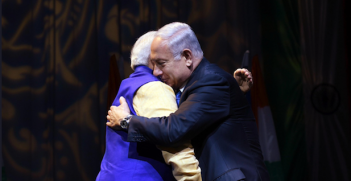100 Years Since the Balfour Declaration: Birth of an "Irrepressible Conflict"

From humble beginnings, the Balfour Declaration has sparked one of the longest unresolved international disputes in history. At its centenary, Arab-Israeli troubles look no closer to ending.
It is doubtful whether any official letter from a senior government minister to a private citizen harboured so many unintended long-term consequences or conveyed the seeds of such an intractable international dispute as did Arthur Balfour’s letter to the wealthy leader of Britain’s Jewish community, Baron Walter Rothschild, on 2 November 1917.
In that short but extraordinary communication Lord Balfour, foreign secretary in David Lloyd George’s wartime coalition government, committed Britain to provide a homeland to the world’s Jewish population in the Ottoman Empire’s territory of Palestine. The offer was based on an assumption that upon the collapse or defeat of the Ottomans, Britain would be allowed to preside over a Palestinian protectorate and maintain an imperial presence in the Middle East.
Although the Balfour offer was applauded by the international Zionist movement, especially in Eastern Europe, it was opposed by a large segment of British Jews, including the only Jew in Lloyd George’s Cabinet, Edwin Montagu, a future secretary of state for India. He belonged to a sizeable community of affluent, educated Jewish Britons known as ‘the Cousinhood’. They felt comfortably assimilated into British society and could see no justification for a new homeland. Indeed, Montagu even doubted that internationally there existed a ‘Jewish people’.
Balfour’s letter to Rothschild contained no specific plan or timetable, but its most critical promise was that “nothing shall be done which may prejudice the civil and religious rights of existing non-Jewish communities in Palestine, or the rights and political status enjoyed by Jews in any other country”. This proviso was inserted by British officials and formed no part of the Zionists’ own proposal to Balfour.
The most influential British lobbyist for the Zionist cause had been Chaim Weizmann, a talented Russian-born biochemist then occupying a lectureship at Manchester University. Weizmann befriended C.P. Scott, proprietor and editor of the Manchester Guardian, and introductions to Prime Minister Lloyd-George and Foreign Secretary Balfour were arranged. Steeped in Old Testament scripture, the Welsh Baptist prime minister was predisposed to sympathise with Zionism, just as a later US Baptist president, Harry Truman, would confess his sympathies with the cause. At this stage, the case for a Palestinian homeland did not carry any direct commitment to an exclusively Jewish state. It was still assumed officially that Jews and Arabs could co-exist within a unitary state.
The Balfour Declaration was issued at a critical phase of the Great War, but unbeknown to the British public it flatly contradicted a secret agreement negotiated with a family of Arab leaders to help establish a new Arab state in the large swathe of Ottoman territory between Mesopotamia and the Arabian Peninsula. During 1915-16 the British had been anxious to promote an Arab uprising against the Turks, to be led by the grand Sharif of Mecca, Hussein bin Ali and his three sons. The British high commissioner in Cairo, Sir Henry McMahon, led the correspondence with the Sharif for a time, but the most critical collaboration arose from meetings between the Sharif and two young diplomats—the Scottish baronet, Sir Mark Sykes, and a French colleague, Francois Georges-Picot.
The Sykes-Picot agreement of May 1916 contained the seeds of a plan to vest Britain and France with post-war spheres of influence in the defeated Ottoman provinces from Syria to Arabia. The Sharif and his sons did later assist the British war effort, principally by disrupting rail traffic on the critical Damascus-Medina route, and the Sharif was proclaimed king of the Hejaz, but it soon became obvious that a Palestinian mandate would not be allowed to fall under Hussein’s control.
Britain assumed full control of Palestine in July 1920, two years before formal signature of the League of Nations mandate. As president of the British Zionist Federation and later as head of the Jewish Agency, Chaim Weizmann became heavily involved in the establishment of Jewish institutions of governance in Palestine. Significantly, the wording of the League’s mandate instrument incorporated the Balfour Declaration, and once again the Zionists were permitted to propose the draft wording. Moreover, the draftsmen did not identify Arabs as the non-Jewish inhabitants of Palestine.
Arab-Jewish conflict became widespread very early in the mandate period, which in turn bred disillusionment with the British administration, but there were still some Arabists in the British political elite who thought Arab interests could be protected. Member of the Lloyd-George coalition government Lord Curzon had opposed the Balfour Declaration and gravely warned of “trouble ahead”. A succession of British administrators in Palestine soon concluded that they could not satisfy the interests of both Jews and Arabs, with one newly arrived high commissioner, Sir John Chancellor, describing the Balfour Declaration in 1928 as a “colossal blunder”.
Frustrated British attempts to regulate the influx of Jewish immigrants and to impose restrictions on the disposal of Arab land provoked serious violence centred on Jerusalem’s sacred sites in 1929, and the 1930s witnessed a series of British commissions of inquiry into the viability of an Arab-Jewish state. The Peel Commission concluded in 1937 that the mandate had become unworkable and that partition of Palestine should be the objective. It stated “an irrepressible conflict has arisen between two national communities within the narrow bounds of one small nation. There is no common ground between them. Their national aspirations are incompatible”.
Further inquiries produced contradictory or inconsistent recommendations, but a May 1939 white paper aimed for a bi-national Arab-Jewish state within 10 years. By now, however, the British had become regular targets of violence from both Jews and Arabs, including Jewish terrorist organisations Irgun and the Stern Gang. By the end of the World War II, the Jewish Agency’s militia, Haganah, had also turned against the British, and it was not surprising that the Attlee government decided in February 1947 to abandon the mandate. In November of that year the United Nations endorsed boundaries for a bi-national sovereign state, and the British announced that their withdrawal would take effect on 14 May 1948.
The Jewish national leader, David Ben-Gurion, was unable to persuade the British to remain to assist with the implementation of the UN resolution. The high commissioner—with the last of Britain’s 100,000 troops—departed Palestine on 14 May, and the Jewish leadership proclaimed Israeli independence later that day. US President Harry Truman accorded diplomatic recognition to Israel within minutes of the independence proclamation but the British government withheld it. The Jewish academic who had persuaded the Lloyd George Cabinet into the Balfour Declaration 31 years earlier, Chaim Weizmann, was invited to serve as president of the new republic.
The painful sequence of events following the May 1948 declaration of Israeli independence is all too familiar, leaving the world with the longest unresolved international dispute in United Nations history. Perhaps Lord Balfour’s remarks in a 1922 House of Lords debate offer a clue as to why he and his colleagues allowed the Zionist cause to receive so much endorsement: “Zionism, be it right or wrong, good or bad, is of far profounder import than the desires and prejudices of the 700,000 Arabs who now inhabit that ancient land”.
Peter Boyce AO is an adjunct professor with the University of Tasmania’s Politics and International Relations Program and president of AIIA Tasmania Branch.
This article is published under a Creative Commons Licence and may be republished with attribution.





